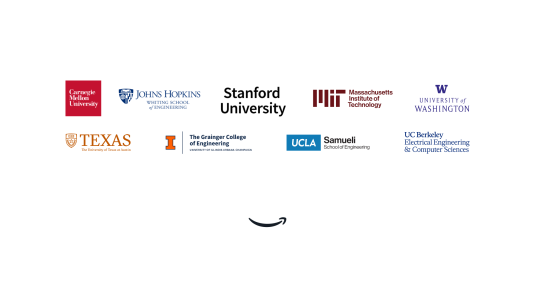Pi Day is an annual celebration of the mathematical constant π (pi), and is observed on March 14 since 3, 1, and 4 are the first three significant digits of π. Pi Day was first observed in 1988, and since then celebrations of the day often have involved eating pie, or holding various mathematical competitions.
To mark Pi Day this year, Amazon Science utilized a Times Square billboard normally used by Amazon Music to honor scientists, engineers, and mathematicians past, present, and future.
The billboard display ran from midnight to 8 a.m. and again — for 3 hours and 14 minutes — from 3:14 p.m. to 6:28 p.m. The display (which you can watch above) began by honoring Marie Curie, the first woman to be awarded a Nobel Prize in 1903 for her contributions to physics. It was Curie who once famously said, “Nothing in life is to be feared, it is only to be understood. Now is the time to understand more, so that we may fear less.”
On Pi Day, we honored some of the scientific giants on whose shoulders we stand, feature a few key accomplishments achieved by Amazon’s researchers and engineers, and highlight some of our university collaborators who are developing the next generation of STEM talent who will help us understand our world more fully, so we may fear less.
For, as Alan Turing once said, “We can only see a short distance ahead, but we can see plenty there that needs to be done.”
Below are items highlighted on the Times Square billboard:
- Marie Curie — 21911
Curie — the first and only person to win two Nobel prizes in scientific categories — won her second Nobel Prize in 1911 “in recognition of her services to the advancement of chemistry by the discovery of the elements radium and polonium, by the isolation of radium and the study of the nature and compounds of this remarkable element.”
- arXiv — 2035720
arXiv “hosts more than 2,035,720 scholarly articles in the fields of physics, mathematics, computer science, quantitative biology, quantitative finance, statistics, electrical engineering and systems science, and economics.” arXiv was founded by Paul Ginsparg in 1991 and is now maintained and operated by Cornell Tech.
- Alexa — 11614
Alexa was introduced to the world on Nov. 6, 2014. Now, eight years later, customers in more than 80 countries interact with Alexa billions of times each week, and Amazon and Lockheed Martin are sending the first Alexa to space as part of Callisto, a technology demonstration on NASA's upcoming Artemis I mission.
- Albert Einstein — 1879
Albert Einstein was born in Ulm, in Württemberg, Germany, on March 14, 1879. He was awarded the Nobel Prize in Physics in 1921 “for his services to Theoretical Physics, and especially for his discovery of the law of the photoelectric effect.”
- USC Viterbi School of Engineering — 7,930,681,085
USC’s engineering school is named for Andrew Viterbi who earned one of the first doctorates in electrical engineering ever granted at USC. The Viterbi Algorithm, a mathematical formula to eliminate signal interference, paved the way for the widespread use of cellular technology.
- Amazon — Lab126
Located in Sunnyvale, Calif., the team at Lab126 designs and engineers the Amazon Astro robot, Fire tablets, Kindle e-readers, Amazon Fire TV, Amazon Echo, and other devices. They’re also exploring how devices are accidentally damaged — and how to help ensure they survive more of those incidents.
- Katherine Johnson — 71962
Katherine Johnson did the trajectory analysis for NASA’s Friendship 7 before it launched in 1962. The complexity of the flight required the construction of a worldwide communications network, but astronauts were wary of the electronic calculating machines. John Glenn asked to have Johnson run the numbers by hand. “If she says they’re good,’” Johnson recalled Glenn saying, “then I’m ready to go.” Glenn’s flight was a success.
- Columbia Engineering — 1150
Edwin Armstrong developed FM radio on Columbia's campus at 1150 Amsterdam Avenue in New York. During an IRE conference in 1935, he described FM radio “and then turned on his receiver in front of the audience. An FM transmission … came in totally free of static and, thanks to the wide audio spectrum being used, with a fidelity never heard before. A stunned audience listened to a live music performance transmitted with remarkable clarity and to a series of sounds, such as a glass of water being poured or a piece of paper being torn — which would have been unrecognizable over AM radio.”
- Amazon S3 — 16
Amazon S3 (Simple Storage Service) is an object storage service that offers industry-leading scalability, data availability, security, and performance. It was launched 16 years ago on Pi Day, as the first generally available AWS service. At the 2021 ACM Symposium on Operating Systems Principles, Amazon researchers won a best-paper award for their work using automated reasoning to validate that ShardStore — a new S3 storage node microservice — will do what it’s supposed to.
- Alan Turing — 186
Alan Turing, WWII enigma codebreaker and father of computer science, had an IQ of 186. In 1935, when Turing was 22 years old, he wrote a paper titled, “On Computable Numbers, With an Application to the Entscheidungsproblem” (German for “decision problem”). The paper is widely recognized as having provided “a conceptual model for modern computers.”
- UCLA Samueli School of Engineering — 3420
The first internet transmission was sent on Oct. 29, 1969 from 3420 Boelter Hall at UCLA. The message sent to Stanford Research Institute on the evening of Oct. 29 was meant to be “LOGIN.” However, the system crashed, so the first message sent over the internet was: “LO.” The next attempt was a success, and the original Interface Message Processor, known as IMP No. 1, the equivalent to today’s router, still stands in Boelter Hall.
- Amazon Research Awards — 385132
Amazon, via the Amazon Research Awards (ARA) program, has funded more than 385 research proposals at 132 universities since 2018. The ARA program funds academic research and related contributions to open-source projects by top academic researchers who have used their research awards to help improve MRI scans, create computational simulations of the human heart, understand the impact of aerosol-cloud interactions on climate, and teach robots to behave like schools of fish.
- Grace Hopper — 6
The Cray XE6 “Hopper” supercomputer was named after computer science pioneer Grace Hopper. One of the first three computer “programmers,” Hopper was responsible for programming the Mark I. As head programmer for Remington Rand, she worked on the UNIVAC I (Universal Automatic Computer). In 1952 her programming team developed the first computer language “compiler” called A-0. Her team also developed Flow-Matic, the first programming language to use English-like commands.
- Caltech — 9019
Scientists and engineers at Caltech and NASA’s Jet Propulsion Laboratory (JPL) landed the Mars Pathfinder on Mars on July 4, 1997 and have been operating rovers ever since — or for 9019 Earth days on March 14. Over a three-month period, Pathfinder returned 2.3 billion bits of information, including more than 16,500 images from the lander and 550 images from the rover, as well as more than 15 chemical analyses of rocks and soil and extensive data on winds and other weather factors.
- Blue Origin — 19314
New Shepard has flown 19 consecutive successful launches, including 3 flights with a total of 14 astronauts aboard. Named after Mercury astronaut Alan Shepard, the first American to go to space, New Shepard is “a reusable suborbital rocket system designed to take astronauts and research payloads past the Kármán line – the internationally recognized boundary of space.”
- Georgia Tech — 161972
John Young, who became the 9th person to walk on the moon in 1972, graduated from Georgia Tech's Guggenheim School of Aerospace Engineering. Young served as commander of Apollo 16, spending three nights on the moon’s surface and driving 16 miles in a lunar rover. Young was also at the helm for the first space shuttle mission, STS-1, in April 1981.
- University of Washington — 14492
Waldo Semon, a University of Washington alumnus, conducted 14,492 experiments to develop synthetic rubber used during WWII. Semon is best known for inventing vinyl, the world's second most-used plastic. Semon held 116 patents, and was inducted into the Invention Hall of Fame in 1995 at age 97.
- Alexa Prize — 24806391
There have been more than 24,806,391 interactions with Alexa Prize socialbots. That number will only continue to climb as the competition meant to help advance the science of conversational AI continues. Last year, Team Alquist from Czech Technical University won the Alexa Prize SocialBot Grand Challenge 4 competition.
- Research areas
- Research areas
- News & blog
- The latest from Amazon researchers
- The latest from Amazon researchers
- Amazon Research Awards
- Research collaborations
- Overview
- Carnegie Mellon University
- Columbia University
- Hampton University
- Howard University
- IIT Bombay
- Johns Hopkins University
- Max Planck Society
- MIT
- Tennessee State University
- University of California, Los Angeles
- University of Illinois Urbana-Champaign
- University of Southern California
- University of Texas at Austin
- Virginia Tech
- University of Washington
- Amazon Research Awards
- Research collaborations
- Overview
- Carnegie Mellon University
- Columbia University
- Hampton University
- Howard University
- IIT Bombay
- Johns Hopkins University
- Max Planck Society
- MIT
- Tennessee State University
- University of California, Los Angeles
- University of Illinois Urbana-Champaign
- University of Southern California
- University of Texas at Austin
- Virginia Tech
- University of Washington



































